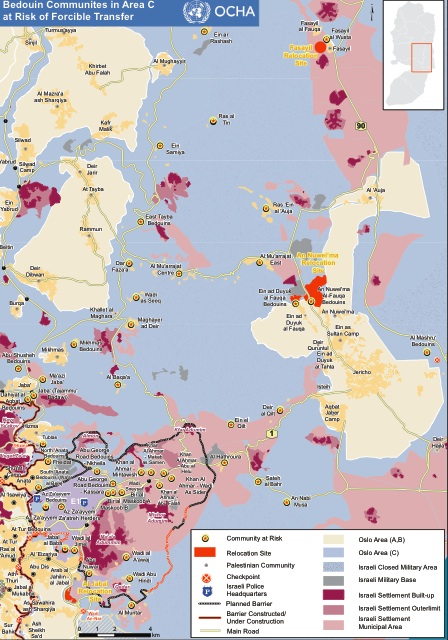The Israeli military administration has published a new plan of expulsion of Bedouin families from their communities and to relocate them in new cities. This is tightening the threats to the Bedouin in the Jordan Valley and may form another step towards the fragmentation of the West Bank.
Ever since Israel occupied the West Bank, the Bedouins have been forced to relocate several times to make space for new Israeli settlements, new so-called ‘nature reserves’ and military firing zones. The so-called Civil administration, the Israeli military authority that implements the occupation in the West Bank, has filed for objections plans for establishing a new settlement in the Jordan Valley. The public now has 60 days to submit objections. Mohamed Elias, representing the Wall and Settlement Unit in the Palestinian Authorities following the legal cases of the Bedouin communities, says that it is yet another plan to confiscate land in area C. He has sent an objection to the occupation authorities based on the fact that the public has scarce knowledge of what is going on and no consultation process has been implemented. According to Mohamed Elias the construction of the new settlement will force around 15000 Bedouins from their lands.
The Jordan Valley is a sparsely populated area and Israel considers it the West Bank’s most important land reserve with great natural resources as fertile land and water as well as a geostrategically central area. The Jordan Valley is part of what is called “Area C’. According the Oslo agreement Area C parts of the West Bank are under full Israeli military and civil control. This was supposed to be handed over to Palestinian authorities by the year 2000, but this has never been fulfilled. 61% of the West Bank are Area C. The new areas to which the Bedouin are supposed to be confined are located in area A and B, which are under control of Palestinian authorities.
Bedouins not consulted
According to the Israeli Administration the construction of ‘development towns’ will give the Bedouin communities better living standards, providing proper housing conditions, claiming its proposal suitable to the “dynamic changes” the Bedouins are undergoing. In reality, it is nothing more than part of Israel’s ethnic cleansing policies, which will destroy the Bedouin life and dump them anywhere, where they are not an obstacle to Israeli colonialism.
Fact is that the Bedouins communities have not been consulted in the planning stages. As the Palestinian legal submission to the courts states, the plan is forced upon them in the interest of the colonizer and does not consider the Bedouins traditional way of living. Bedouins live in small communities and their main livelihood is livestock. In total 46 Bedouin communities, around 15000 people, will be deprived of their land and livelihoods. The plan is to build a new town called, Ramat Nu'eimeh in Fasayel, both north of Jericho. Ramat Nu'eimeh is supposed to confine about 12 500 people.
Seperation of Palestinian territory
Since time Israel is working on the ethnic cleansing of the Bedouin in the so-called area E1 to the area of Abu Dis near East Jerusalem. Israel needs to make space for the settlement projects of the so-called E1-area, an area between Jerusalem and the Israeli settlement Maale Adummim. Israeli authorities want to expand construction in order to connect the two cities. This will practically cut off the contact between the north and south part of the West Bank, according to Elias.
Evacuating Bedouins from East Jerusalem, Jericho and the Dead Sea will enable Israel to close the road between Jerusalem and Jericho and by that close the area between Jerusalem and the Dead Sea to Palestinians. This will separate the Palestinian territory and create an uninterrupted line between Jerusalem and the Israeli settlements in Jordan Valley. This will make it possible for Israel to expand the settlements in area E1 towards the Jordan Valley. The Stop the Wall Campaign says that this strategy is a part of Israel’s disengagement plan for a ‘Palestinian state’ made up of isolated Bantustans: Ramallah and Salfeet in the center will be separated from Nablus in the north by a belt of settlements and from Bethlehem and Hebron in the south by the E1 plan. According to Stop the Wall another part of the plan is the expansion of the road between Taybeh village east of Ramallah until al Oja. This will then be the only Palestinian connection for the West Bank to Jericho and the Jordan Valley.
Stop the Wall insists: “The Palestinian Bedouin communities as well as the Palestinian people as a whole are resisting these plans of ethnic cleansing and Bantustanization. We are working on many levels, including legal procedures, grassroots mobilizations, lobbying and campaigning. If the international community is serious about their statements for peace and human rights, then they need to act now. The United Nations Agencies – and with this the entire international community – have been officially informed about these plans years ago by the Israeli authorities. What are they waiting for to take effective action?”

